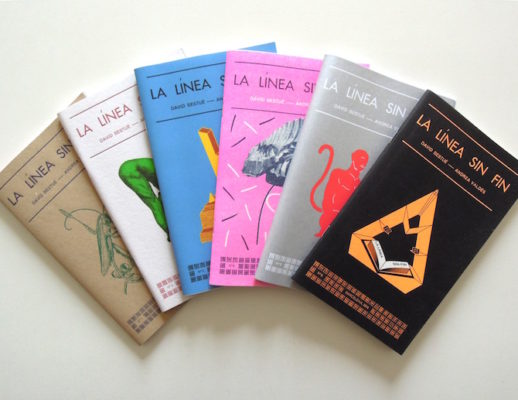Search
To search for an exact match, type the word or phrase you want in quotation marks.
A*DESK has been offering since 2002 contents about criticism and contemporary art. A*DESK has become consolidated thanks to all those who have believed in the project, all those who have followed us, debating, participating and collaborating. Many people have collaborated with A*DESK, and continue to do so. Their efforts, knowledge and belief in the project are what make it grow internationally. At A*DESK we have also generated work for over one hundred professionals in culture, from small collaborations with reviews and classes, to more prolonged and intense collaborations.
At A*DESK we believe in the need for free and universal access to culture and knowledge. We want to carry on being independent, remaining open to more ideas and opinions. If you believe in A*DESK, we need your backing to be able to continue. You can now participate in the project by supporting it. You can choose how much you want to contribute to the project.
You can decide how much you want to bring to the project.

La línea sin fin is a project by Andrea Valdés and David Bestué that revises the history of Catalonia, from the second half of the 19th century up until 2035, in a collection of 6 fanzines designed by Setanta. The first volume was published in 2013, while the last was presented in December 2014. Despite the relative agility with which these different publications have been presented, behind the content of each one of these chapters one can perceive an intense process of investigation. Each instalment has counted on the collaboration of Jeleton and Jonathan Millan, and a large number of other authors who have also formed part of the project.
How and when does La linea sin finbegin?
DB: Six years ago. The origin was a piece of work I did about the architect Enric Miralles. I realised he formed part of an authentic way of doing things here, one which incorporated ambits seemingly as far apart as humour, sculpture or poetry, and that this tradition or heritage wasn’t explained by the usual names such as Miró, Picasso, Dalí or Tàpies. Having done this piece about Miralles I wanted to investigate this way of being and doing, and the result was the video “Historia de la espuma” (2006-2007). Andrea and I began talking in 2008, and from then on we worked together on this investigation.
AV: He sent me some 30 or 40 pages of notes he had used to make the video, which is interesting because it has a touch of poetry while at the same time contains an investigation that could be reformulated and amplified a lot. For me it was a way of focussing on something I couldn’t be bothered with and of which I knew nothing about. I found it hard to feel comfortable with the idea of writing about something without being really well informed. The writers I liked most were people who talked about very specific things, in depth, and I thought that if I didn’t know where I was from, it was like writing in a shopping mall. The excuse was that focussing on where I’m from is tricky, as it is for David, because he also doesn’t represent the Catalonia that must be.
DB: When we began it seemed as if the symbols, or Catalan mythology, were being restructured, while we didn’t feel identified with any of it. We found there was a series of things that to us seem as Catalan, or more so, than what was being sold to us as Catalan. With this we carried out an exercise in archaeology; we sought within our references some constants that repeated over the years.
AV: It was a very healthy exercise. And also it’s a way of saying: these people will do for us.
The fanzine format contributes to this idea of self-legitimation.
DB: Yes, although there was a moment when we thought about bringing out a book. We wrote it all out and we were left with a monster of some 1500 pages. To do it well, we would have needed many years and it could have been very exhausting. On the other hand, the idea of doing it as a fanzine, in instalments, made it all much more agile.
AV: One thing I’ve liked, and it’s perhaps quite specific to the context of contemporary art, has been the fact of being able to incorporate error in the writing. Initially I found it hard to accept there were typographical errors in the first issue. In the end I thought I shouldn’t worry, as the form of production we were pursuing was based more on experience: not being rigorous, to carry on producing, working with a lot of freedom. Hence why all of a sudden we dedicate three pages to a freak, while there are other major absences. But this also represents that moment! No doubt if we were to do it in three years time, this history would be very different.
DB: For us it is a history of Catalonia that serves us. There has been a lot of investigation and in the end we have wanted to present it in this fanzine format, on the understanding it is an exercise that everyone can do. And in fact everyone ought to. Because it’s not a patriotic thing, so much as you are in a territory, in which a series of things have passed, or are going on, all at the same time and in a given moment you have to chose what interests you out of all of this.
The fact of always following the usual chronological scheme to order certain incidents contrasts with the free and fairly un-rigorous way the contents are presented and explained in “La línea sin fin”. Does appropriating a specific form of legitimation to talk about other things represent a provocation against the dominant historic discourse?
AV: It’s true there is a certain authority in constructing things chronologically in a vector. If you use the same vector, but put in all sorts of nonsense, the effect is quite interesting. In the beginning we had organised the content thematically, it was much more thoughtful but we wanted to cover so much the reflection never moved forward. It was like a simultaneous history and it was really nice but the reader would have got lost amidst so much content. In the end we made a chronology of everything we had: from anecdotes, that are very important for us, to major incidents. The provocation in the moment of making the chronology came when we were surprised to see there were certain incidents that occurred simultaneously. As we have a scholarly tendency to understand first one thing happened and then another, seeking an aesthetic in terms of speech that has a lot to do with ideas of evolution and progress. But when you adopt a chronological approach you see that in reality what there was, was chaos. The chronology is anarchic; it’s an order, but it’s also a disorder in relation to your construction.
In the article Jaime Casas wrote for El Mundo about “La línea sin fin”, he mentioned the need to talk about Catalonia. Does this need continue to exist? On the other hand, the exploitation of culture in our context passes for the construction of an appearance of historic identity, of tradition, which as soon as you explore it a little, topples. Nationalism creates an identity having made a revision of history to seek some pillars that hold all this up. Do you think an identity ends up being found or is perhaps one being dismantled?
DB: In my own particular case, it was important because it arose from what came before, which was “Formalismo Puro” or the work about Enric Miralles. In the latter particularly, for you come to realize there are things that if you don’t rescue them and talk about them, they disappear. There were things covered in dust and we were keen for people to know about them.
AV: There is also the fact that Catalonia, as it doesn’t have a State, has found an extremely important tool in culture. This exploitation means some things and not others are selected. That’s where the idea we had to talk about Catalonia came from. Ortega y Gasset is now perhaps a bit out date but I like it when he says a nation is not the place where you have been living for many years, it’s a project for the future. This project is being constructed but there are those who construct it in relation to a very stuffy idea. I like to think there are those who are building it according to other parameters.
DB: I believe, that since the transition, a considerable number of this generation of artists are not the sons of the bourgeoisie but the children of immigrants. As artists we have a tradition and a different relation to identity, one that is much more complex. It is a slightly schizophrenic vision, although one I love, of being at the same time both inside and outside. You feel as if you form part of the Catalan culture but at the same time you don’t want to be labelled with it. We’re the children of immigrants, and we’re also building culture in Catalonia and this will continue to happen: the children of immigrants who are coming now will also construct their history of Catalonia and will also have to make a fanzine in ten years time. They’ll have to write their viewpoint and explain what it means to have been born here. And this is very interesting. It’s what we have done and it’s what others will have to do, and then others, and others…

Anna Dot was born on a Sunday in April. She is from Torelló and works between two worlds, worlds that she cannot perceive as being in any way separate: one of artistic production and one of reflection, writing about contexts of art.
"A desk is a dangerous place from which to watch the world" (John Le Carré)